28 Jul 2014
I always wondered why high-tech super smart analytics systems never show you the most important metrics of gameplay: user lifetime and lifetime value, known as LTV. Lifetime dynamics and LTV are the two most important and high-level metrics in product development and still not a single analytical platform calculates them, not to mention putting them in the spotlight. How else can you measure if the new build with all the changes was a success? Going through the percentage of payers, ARPDAU, n-day retention and other detailed metrics is a must. But this approach creates the vicious situation where only analytics and product leads know what’s going on with a product. What about other stakeholders? What about the high-level picture, using a single metric to judge?
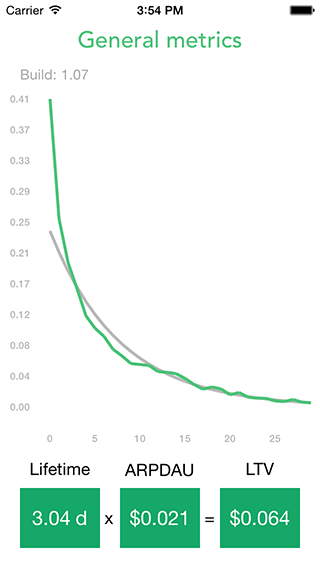 So I went on and created my own solution for Game Analytics platform that I use in some of my own products. Now I've gone even further and made it open source, available on Github here. The idea is quite simple: fetch GA data, recalculate it, make some predictions if needed and come up with a few major metrics: lifetime, average ARPDAU and LTV. Ah, and I used Swift to build it, so it could be a little problematic to compile it and install on your device at the moment. But let’s embrace the future, dear reader! Check out more details and explanations at the bottom of the Github project page. If you’ll find it useful, I would be pleased to know that.
So I went on and created my own solution for Game Analytics platform that I use in some of my own products. Now I've gone even further and made it open source, available on Github here. The idea is quite simple: fetch GA data, recalculate it, make some predictions if needed and come up with a few major metrics: lifetime, average ARPDAU and LTV. Ah, and I used Swift to build it, so it could be a little problematic to compile it and install on your device at the moment. But let’s embrace the future, dear reader! Check out more details and explanations at the bottom of the Github project page. If you’ll find it useful, I would be pleased to know that.
Note: GA still doesn’t provide a way to segregate data both by build and ad group or even country, only one dimension at a time. But GA has promised to fix this in the future.
21 Jul 2014

Monetization was always one of my weakest spots. How many times have I made a game good enough to gain user traction but that was lacking this critical component. And how often it led to a devastating results. So I decided to take time and reflect on this topic, starting from behavioral mechanisms to structural elements and specific realizations. And instead of speculating in the abstract, I want to discuss only the cases proven by me or one of my friends (and by that I mean that one of us paid real money in a specific case). The aim is to bruteforce the problem and to go through some interesting and important cases in order to find the psychological foundation for player spends.
This post is dedicated to the lowest and most important level of the monetization mechanisms: behavioral triggers. Things on the bottom of our mind, telling us “push bank button” and “confirm the purchase”. So here are the triggers I came up with.
1. Expansion
Of lands, map pieces, available building slots and everything else. Some examples are map expansion in Boom Beach and purchasable plots in Township. Expansion is a very natural desire, as it comes with new opportunities and mechanics, and can be tied to a big element of surprise. The main trigger here is actually the feeling of tightness and limitation the game creates, forcing the player to expand by preventing some gameplay mechanics from being executed before expansion.
2. Accumulation
Of resources, currencies, artifacts, elements and so on. Triggers here work as artificial frictions, imposing a limitation on storage that restricts how much a player can accumulate. This limitation can be lifted by purchasing extra storage. Barn expansion in Hay Day is a good example, as is upgrading the gold and resource keeps in Clash of Clans. Creating a deficiency of the resources needed to upgrade storage is a really powerful money-sink. At first glance, expansion and accumulation look somewhat similar. However, there are few major differences. Accumulated resources are abstract, and therefore could be taken back in an aggressive manner, creating a protection trigger.
3. Protection
As an unwillingness to lose resources or rollback to the previous state. Normally protection is associated with PvP mechanics, but in my opinion this is just a way to justify the loss. I can easily imagine a PvE game with some aggressive environment that keeps bugging the player, throwing him back once in a while. Two important things here: First, it’s necessary to give the player an option to push back through revenge and recouping losses. Second, the player should be able to protect their belongings by building powerful defensive forces (as in Boom Beach), turning on shields (as in Clash of Clans), with help from friends or by any other means.
4. Domination
Speaking of revenge, there’s no sweeter feeling than destroying an enemy who’s attacked you before. I think it’s a mix of domination and a sense of justice that leads to such a positive experience. And I really believe that this true for both genders. It’s just a matter of how exactly the player will dominate. Men usually do it with brute force, face to face. Women usually do it through social means that involve a third party as a judge. Any good PvP game could be used as an example of how this works for male players, while any good farming/building game with a social validation mechanism can show how female players experience domination through competition.
5. Progression
Impatience is created as a discrepancy between the player’s perception of the ideal game pace and real game progress. A good example of this is how timers of all sorts are amplified by exceeding resources. Ideally, this trigger should occur in a situation where a player has progressed too far in some ways and needs to catch up in others. Energy is another method, but sometimes it can be seen as a total block, kicking the player out of the game. Energy is mostly used to unlock more gameplay sessions or actions and timers work for items and resources. Playing with difficulty as in Candy Crash Saga is a good indirect way. Another good way is to create some deficit such as when collecting rare resources is necessary to start some process or craft something (e.g. get 4 hammers to start the building process).
Top grossing games such as Boom Beach, Game of War and Candy Crash Saga employ all five of these triggers. Casual games often lack the protection/domination pair at all and there’s lots of potential to implement soft versions of these mechanisms. Candy Crash Saga is a good example of doing exactly that. The game gives you a way to dominate your friends with the visual representation of your progress on the map. And it constantly throws you back to the beginning of the level urging you to buy some powerups as a sort of protection.
17 Jul 2014
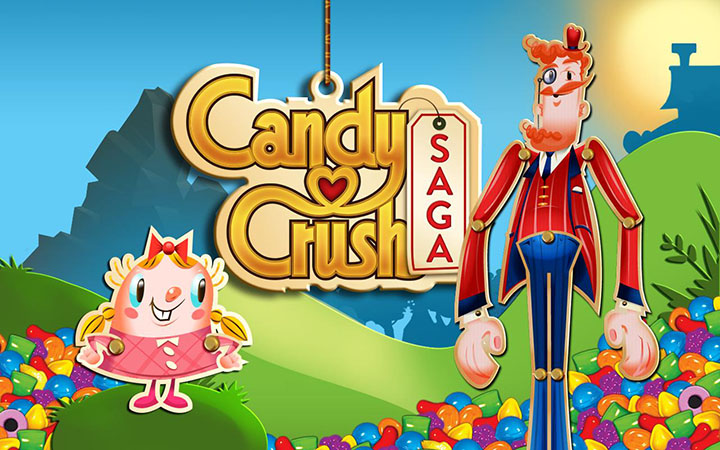
There's not too much to be added about Candy Crash Saga at this point. However, a few days ago I discovered a whale among my friends who reached the last available level in the game (and it’s something about 400, for a second). And as whales make hundreds of transactions each, that’s a lot of data to analyze. A single whale could show you how the entire game monetizes. The whole money-sink distribution could be built upon one user. Isn’t that cool? So, keeping in mind the limited accuracy, let’s take a look.
But first, just to remind you, a few words on how CCS monetizes. There are a few major sinks, all connected to what I call behavior trigger #5, slow progression. Basically, with its wavelike difficulty pattern for levels, CCS puts the player in a position where they need to play a level hundreds of times or pay to win (and still pay tens of times on higher levels). There are a few ways a player can pay their way to win a level:
- Additional moves, prompted to buy when a player fails the level.
- Major buffs that can be purchased before the level starts. These can also be won in the daily lottery and dropped on level.
- Minor buffs that can be purchased right in the middle of the level. They are also provided when a player buys additional moves for the 2nd or more time in a row.
- Additional lives that basically serve as energy.
So, this is how an actual distribution of the purchases looks for a single specific whale:
- 70% – additional moves
- 20% – on-level buffs (most useful is the one that breaks a single candy)
- 10% – additional lives
First, that totally makes sense for me, as the sinks are sorted by the amount of time invested while playing a level. The closer you are to winning, the more you are ready to pay. Second, the least sophisticated items are the most popular ones. Developers often go another way, giving the simplest ones for free/cheaper and providing complicated ones as paid/expensive. I’ve made this mistake a few times too. The best way is to focus on selling the simplest things and to use complex items for variability, enriching the game experience.
08 Jul 2014
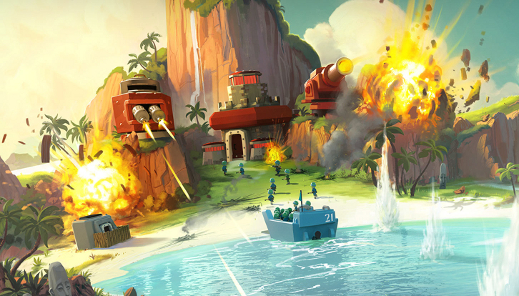
I’ve been playing Boom Beach a lot over the past few weeks, and have progressed to level 32 with about $100 of in-game purchases. At this point I think that the game has one of the best monetization and retention mechanisms I’ve ever seen. I won’t try to repeat the great job Mikhail Katkoff has done in his overview of the game, but I would like to share a few thoughts on these two components of the game design and how they’re supported by competition.
Retention
There are three main activities in Boom Beach: building, army training, and attacking enemy bases. Two complementary loops occur within this structure that drive short-term and mid-term retention.
Short-term retention is achieved by very quick iterations of unit construction — 5 to 30 minutes for early-to-mid level. There are several building queues (one for each boat that you have), but as most of the soldiers need to be kept ready for battle, these lines essentially work together as a single queue with many simultaneous timers. (As a side note, if I tried to replicate these mechanics, I’d probably eliminate multiple timers for the army queue.) When the army is ready it’s time to go fighting. Unlike Clash of Clans, soldiers that are still alive at the end of the battle are retained. This aspect of the competition makes a lot more sense, as it rewards clever play and emphasizes the importance of skill. Often it’s possible to play 3-5 battles in a row—first with AI, as these are easier, and then with other players—without having to go through a replenishment cycle to get more troops. Successful battles are rewarded with resources and minor bonuses such as victory points and shards—elements of leaderboard mechanics and crafting. The whole cycle is basically the battling loop that drives the short-term retention with quick iterations and great rewards.
As the player advances through the game it becomes clear that every minute not spent building is a waste of game time, as it gives competitors the chance to level up more quickly. This is another way that Boom Beach differs from CoC. In CoC there are two default workers, with the option to buy up to three more for hard currency. What these purchasable workers do in CoC is provide shortcuts for game progress. However, as construction acceleration is another, and more important, revenue channel built on top of game progress, these shortcuts cannibalize it. As an example, in CoC, a player buys one additional worker that allows him or her to build X more buildings over the course of the game. It’s a one-time payment. In Boom Beach the player accelerates construction Y times, which is less than X, but more than 1 on average.
The single construction queue also achieves in focusing the player’s attention on completing one building at a time. When you have more than one building in progress, it’s more difficult to track if you have available workers, as well as to remember the time left to complete the next one. With only one building in construction each time, you become really anxious when you realize that you forgot to start a new construction on time. It’s difficult to underestimate the effect of this mechanic on mid-term retention. Half of the times I opened the app just to check if my previous construction was complete and if I could start a new one.
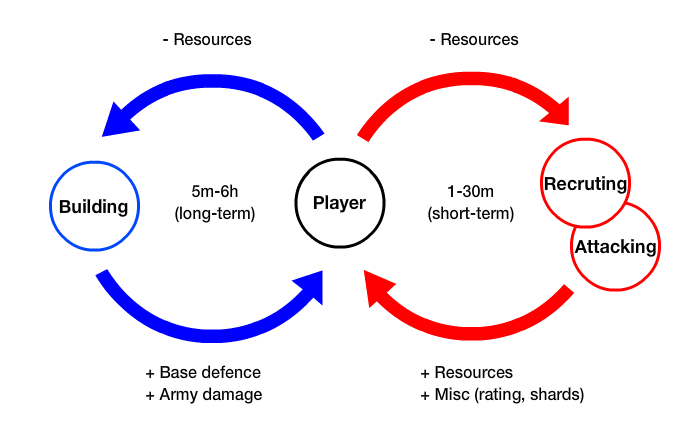
Boom Beach retention loops
Note: durations are for early to mid-game
Competition
While it’s widely known that the success of both Clash of Clans and Boom Beach stems from their PvP modes, I would like to highlight the wavelike pattern of competition for paying players. I don’t really know how miserable life is for non-paying users, as I paid from the start, but I assume the pattern will probably be flatter, as it counts only the play time, not the expense, for these players.
The following opinions are based on observation and speculation, so take them with a grain of salt. Probably I have discovered certain aspects of gameplay that are obvious for an experienced PvP gamer or developer. Anyway. Based on my own experience, it seems that PvP difficulty catches up with player progress following each major breakthrough, often enabled by purchasing items. Initially, opponents don’t put any real pressure on the player. Then, after a while, battles are commonly lost and bases are raided more often. At this point, the player starts to feel like he or she is falling behind, even if this is just a trick of the match-making system. This drives players to pay for items that allow them to upgrade buildings, thus improving army and defense strength. I’m not sure if the match-making system starts supplying weaker opponents at this point or this is just the result of player's rank not matching his improved strength, but in any case the goal is achieved.
After upgrading, the player feels empowered, smashing opponents and wiping out the entire available region of map. However, this triumphant feeling fades away rather quickly in the next 1-2 days, as opponents’ power again increases to the point where the player can’t easily win. Then the win-lose cycle repeats. The blue and red lines on the chart demonstrate how this works.
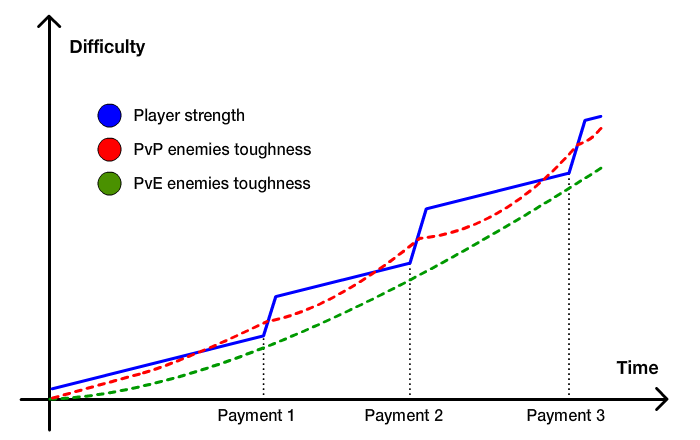
Boom Beach competition curve
This cycle is effective because of one very important thing: A player almost never fights the same opponent twice. The range of opponents is very flexible. And the match-making system provides the best enemies based on current performance, not players’ personal preferences or history of confrontations.
The green line on the chart depicts the role of the PvE (non-player) enemies, which essentially serve as cannon fodder. Their purpose is to increase the number of wins (50% on average in PvP games), even though these wins are not over real players. They also distinguish between tough battles with players (like boss battles) and common battles with mobs. They don’t offer much challenge and progress, but can provide a boost for non-paying users or for paying users who are falling behind.
All in all, great job Supercell! Boom Beach is a real breakthrough from Clash of Clans in many ways. Some improvements could be made, including adding a clan system and social interactions, but the game is still in it's early days so let's wait and see.
 So I went on and created my own solution for Game Analytics platform that I use in some of my own products. Now I've gone even further and made it open source, available on Github here. The idea is quite simple: fetch GA data, recalculate it, make some predictions if needed and come up with a few major metrics: lifetime, average ARPDAU and LTV. Ah, and I used Swift to build it, so it could be a little problematic to compile it and install on your device at the moment. But let’s embrace the future, dear reader! Check out more details and explanations at the bottom of the Github project page. If you’ll find it useful, I would be pleased to know that.
So I went on and created my own solution for Game Analytics platform that I use in some of my own products. Now I've gone even further and made it open source, available on Github here. The idea is quite simple: fetch GA data, recalculate it, make some predictions if needed and come up with a few major metrics: lifetime, average ARPDAU and LTV. Ah, and I used Swift to build it, so it could be a little problematic to compile it and install on your device at the moment. But let’s embrace the future, dear reader! Check out more details and explanations at the bottom of the Github project page. If you’ll find it useful, I would be pleased to know that.




